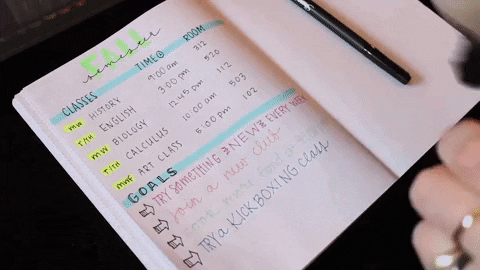10 Ways to Build Your Students' Resilience and Involvement
/Developing resilience is critical to student success. Difficult situations can arise at any point, but during this new chapter of independence, college students -- who may already be experiencing many new stressors all at once, such as busy class schedules, extracurriculars, and competing work, studying and social demands -- might find encountering setbacks and obstacles demoralizing or even derailing. While students with healthy resilience are able to adapt and tackle obstacles that arise, others who lack resilience may develop anxiety, depression or unhealthy coping strategies.
Learning to navigate challenges that arise during this important transition period can set students up for lifelong success. Many colleges are developing resiliency programming to address elevated stress levels of college students and equip them with the tools they need to face roadblocks.
What is resilience?
Resilience is the ability to withstand, address, adapt and adjust to misfortunes, overcome obstacles, and to bounce back from perceived failure, disappointment, or rejection. How a student learns to handle hurdles will have lasting impact in their future careers and relationships.
Building resilience is key to helping students develop the ability to overcome stressful and challenging experiences. Check out our 10 suggestions on how to help improve college student’s involvement and build resilience:
1. Promote Positive Emotions
When facing fear, disappointment and rejection, having a positive outlook offers a better state of mind to tackle problems and manage anxiety and stress. Introducing positive thinking and mindfulness in college students helps them to learn to tolerate and combat negative emotions for an effective way to increase overall positivity. Offer meditation classes in-person or online, and encourage students to come up with positive affirmations to post on a board, wall or virtual feed to inspire positive thinking.
Practice gratitude: Ask students to write down one thing for which they are grateful to help them focus on positivity in their lives: friends, family, stability, health, and more. This activity boosts happiness and inspires optimism in the place of negativity, and helps students feel more connected to others. (Remind students to try this exercise anytime they are feeling negative.)
Identify negative thought patterns, such as imposter syndrome, pervasive feelings of social or academic inadequacy. Teach students to become aware of when these feelings arise, take a moment to acknowledge, question, and stop them in their tracks, mindfully replacing these thoughts with new and positive affirmations.
Feel useful: Encourage students to find opportunities to volunteer, lend a helping hand or mentor on campus. Helping other students or contributing in the community helps develop new skills and instills a sense of purpose.
2. Foster a Sense of Competence
Transitioning from a highly regulated and scheduled childhood to a looser structure of college life requires a great deal of self-discipline, which can be especially challenging for some students who may struggle with ADHD, executive functioning difficulties like prioritizing, time management and organization.
Completing tasks and breaking down steps may be a challenge without the help of a teacher checking on your daily progress. Work may pile up and deadlines may be missed, leading to feelings of inadequacy and frustration.
Connect students with advisors or mentors to help them learn to create and follow a manageable schedule and set daily tasks for themselves. Checking off To Do boxes, whether on paper (bullet journal) or in an app (Trello, Airtable), provides a sense of achievement, helping students to feel good about themselves and their work.
Partner with parents: Before students arrive on campus for the first time, encourage parents to help students build resilience and prepare their child for new independence and responsibilities by helping prepare them for living on their own. Teach them how to cook for themselves, take care of laundry and manage their finances.
Make sure they have a plan for maintaining physical and mental health care needs. This prep will help students arrive on campus with a strong foundation, a feeling of safety and self-reliance, and the confidence to explore new opportunities around them.
3. Teach the Importance of Health and Well-Being
Improving self-care is vital to cultivating resilience, so be sure to help students feel confident and ready to face life’s challenges. College can be a stressful time, and students who aren’t practicing good self-care can fall into unhealthy habits or develop anxiety, depression or poorly manage stress.
For these students, improving resilience is even more critical to their success. When students are taking care of their physical and mental health - getting enough sleep, exercising, eating a healthy diet and staying hydrated, they are able to think more clearly and are better equipped to handle challenges.
Promote campus resources and encourage students to access help when needed, and know where and how to get support. Centralize comprehensive information on health programs, counseling center details and more. Make it easy for students to directly schedule meetings or book appointments with an Advisor, Counselor or Mentor when they are feeling overwhelmed or want assistance getting involved on campus.
Another great way to get students thinking about prioritizing health and well-being is facilitating a group discussion on healthy habits, making a list and encouraging them to set goals and pick new heathy habits to try.
Programming to teach resiliency on campus helps students learn and benefit from coping skills, effective stress management and emotional regulation tools. Improved resilience contributes to a reduction in perfectionist tendencies, alleviates imposter syndrome, and increases a sense of belonging while destigmatizing help-seeking.
4. Encourage Goal Setting
Without clear goals, students may feel lost or incapable. Teaching students to set concrete, achievable goals inside and outside of the classroom provides them with a motivating sense of purpose. Encourage students to work toward goals by focusing on small steps and creating a manageable schedule of daily tasks. This process encourages students to reflect on what they would like to achieve and follow their progress, development and accomplishments, reinforcing that they are capable and in control.
Help students learn to set goals by asking them to think about the following questions.
What do you need to do? (Research and write a lengthy essay)
How will you measure progress? (Create a checklist detailing steps towards completion)
How will you achieve it? (Set aside 6 hours over the next week and a half)
When do you need to finish? (Next Wednesday)
Setting goals presents students with the opportunity to experience setbacks along the way. It also enables them to anticipate possible obstacles that may arise and brainstorm solutions ahead of time. This helps shape students as effective problem-solvers who don’t give up at the first hurdle - in other words, RESILIENT.
5. Develop Problem-Solving Skills
Building off the previous step, it’s important to teach students critical skills and methods on how to calculate risks and deal with difficulties that arise in order to become more like resilient people, adaptable and confident. Students who are able to find solutions to problems in school will be well-equipped to handle issues in the future and outside of the classroom.
Have students write down problems or challenges during class or a group meeting on a board and then collaborate in a discussion to brainstorm different solutions and strategies to address them, or present a single problem and break students into groups to creatively solve it in different ways.
Working together can make tackling a challenge fun, enriching and rewarding, and helps students better understand how to approach and solve problems logically, with patience, pragmatism and persistence. This will help teach students how to anticipate and effectively deal with difficult situations they encounter.
6. Learn to Succeed by Learning to Fail (Better)
Resilence, or a lack thereof, plays out in many areas of campus life. Keeping things in perspective is an essential tool for students, who may be prone to catastrophizing setbacks as the end of the world. Learning to navigate failure in academics, relationships, losing a campus election, or being rejected for an internship or graduate school program, builds fortitude that will follow a student into their future career.
Focus on shifting mindsets to redefine perceived failures as an important part of the overall learning process. Invite alumni, faculty, deans and other staff to speak or record videos sharing stories of past successes, failures and resilience.
What rejections did they face? Did they let it derail or empower them? How did they handle it? Hearing firsthand stories of resilience will help students learn to cope with failures, bounce back, and strategically move forward when faced with adversity.
7. Create Resiliency Event Programming
Offer learning opportunities to help incoming and returning college students learn effective strategies for managing schoolwork and other responsibilities and ensure they know where to turn to for help when they need it. Provide a variety of workshops, learning modules, panel discussions and other in-person and online events for students to explore resilience strategies and tools firsthand.
Offer an asynchronous option for students to follow and complete at their own convenience: Guide students on a developmental pathway to build resiliency through assigned Tracks and Checklists. Develop trainings about problem-solving, health and wellness, positivity, getting active and involved in the community and campus resources. Include videos, quizzes, articles and documentation, resources and more. Incentivize students to complete the track by awarding them a virtual Resiliency badge that can be included in their profile and Co-Curricular Transcript.
8. Encourage Peer to Peer Storytelling and Connections
To help prepare students, offer resiliency training education, outreach and opportunities to connect and learn from their peers’ shared experiences. Create opportunities to encourage students to share about their past rejections and missteps and how they were able to bounce back to inspire students to apply these strategies to their own experience and journey. There are many opportunities to connect your student community in supportive ways!
Launch a video storytelling program for students to share and read stories about effectively navigating setbacks and coming out on top. Hearing directly from another student who turned around a failing average to a top grade through tutoring and other strategies gives students the practical context to comprehend how much resilience can make the difference between failure or success.
Offer workshops, host retreats and reflection events to increase students’ well-being, positive thinking, and awareness of mental health issues and substance abuse prevention.
Connect students with a dedicated app to enhance the well-being of students in your campus community and help encourage students to make small changes in their lifestyles and daily routines to support their emotional health and goals they set for themselves.
Develop a student ambassador team, and have them prompt conversations on your school feed, student group feeds or forums. Encourage them to make regular posts sharing stories, asking questions and offering suggestions to let students know about campus support resources available to them - and how to access them.
Nurture meaningful relationships beyond counseling center professionals. Finding your community and creating a strong support system is incredibly important to building resilience for college students, especially during the pandemic when making new connections became more difficult in the absence of in-person event programming.
Virtual Involvement Fairs present a great opportunity for students to find and join organizations and make new friends on campus based on common interests, even remotely. For students who live on campus, Resident Advisers (RAs) have a unique opportunity to make a major difference in students’ lives and are among the most available and equipped to help students develop coping strategies to address minor issues before they become larger problems.
9. Share Resources via Cross-Campus Marketing Campaigns
There are many ways to raise awareness of your campus’ resources and important information so students know about all of the support systems available. Here are some ideas to help get the word out!
Create an ad campaign on your school’s home page promoting a different campus resource each week.
Implement a weekly Community Feed takeover featuring a different campus resource leading the discussions on the campus feed or in a forum.
Use an engagement platform to promote different ways to get involved on campus. It can be difficult for some less extraverted students to get involved when approaching a group and asking to join in person requires leaving their comfort zone. With an online engagement platform like CampusGroups, campuses can continue to offer inclusive opportunities like Virtual Involvement Fairs and Virtual Meeting opportunities so that everyone can be engaged at their comfort level.
Create and promote events with your engagement platform to focus on developing and demonstrating resilience, managing emotions, workshops and more. Encourage co-sponsoring events between student organizations and groups and between campus resource groups to bring two communities together and expand students' networks.
Utilize Join flyers to connect students with opportunities for involvement. With CampusGroups, Join flyers are easily created for each group, including a QR code for students to scan and learn more about the organization. Print and plaster these flyers everywhere for easy access for students to learn about involvement opportunities and join a club or organization.
Facilitate leadership buy-in, inviting campus leaders and faculty to lead presentations promoting your resilience campaign in class or at campus events, reaching out to different colleges, departments and services on campus. Invite student ambassadors to raise peer awareness of resilience in the classroom, residence life, and among student groups.
Create and share videos, animations, social media campaigns and promotional merchandise like buttons, stickers, shirts and posters.
10. Cultivate a Sense of Agency
When things aren’t going your way, it's important to remember you’re in control of two things - your attitude and your efforts.
Developing agency helps students cultivate their decision-making process and avoid becoming overwhelmed or feeling stuck in difficult situations. When a student arrives on campus, she is suddenly faced with endless choices: courses, clubs, roommates, weekend plans, career steps and more. With this autonomy comes enormous responsibility, and some students may feel the weight of this more than others. Uncertainty and doubt in making smart decisions for oneself can lead to anxiety or inaction.
Help students learn to take back control of the things they can. They should learn to control how much external stimuli you allow, such as Netflix, TikTok, online gaming, social media scrolling. Students should allow some space and time in their day to decompress and declutter their minds through reflection, quiet meditation or exercise. Students need to give themselves the elbow room to hit pause.
Students should take time to pinpoint sources of stress and pay attention to how they react to these stressors. This is vital to developing self-awareness and resilience. Once they realize where stress originates and what negative reactions or behaviors it provokes, they are able to redirect and improve coping mechanisms and strategies.
Especially given this challenging past year, implementing resiliency programming as part of the student experience will truly help set your students up for success. They will be able to learn about themselves and create healthy strategies they can apply in their future careers and lives. They will also learn to celebrate triumphs and learn from stumbles.
Most importantly, they will develop the ability to assess and determine the best ways to approach obstacles with self-assuredness and confidence in knowing they are capable of bouncing back to reach new and greater heights.
Are you interested in learning more about using CampusGroups to support your student engagement goals? Contact us for more information or to set up a demo and tell us about your campus. We’d love to hear from you!
Hello, World!






















